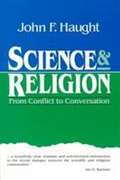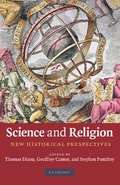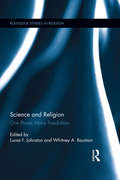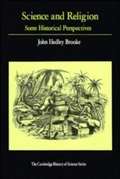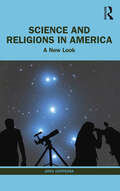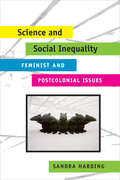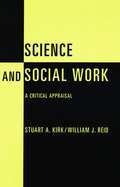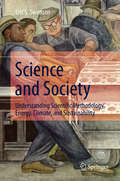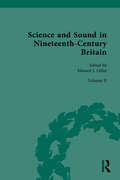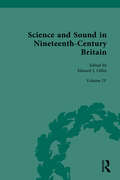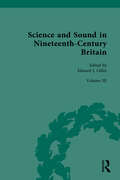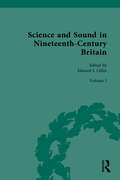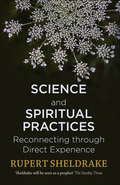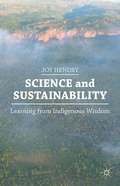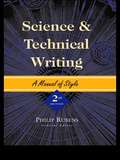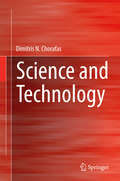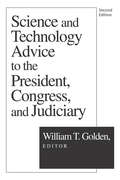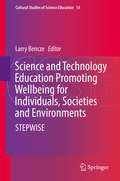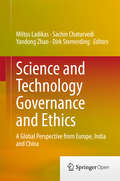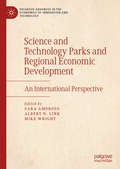- Table View
- List View
Science and Religion: From Conflict to Conversation
by John F. HaughtA guide to dialogue between scientists and believers.
Science and Religion: New Historical Perspectives
by Thomas Dixon Geoffrey Cantor Stephen PumfreyThe debate between science and religion is never out of the news: emotions run high, fuelled by polemical bestsellers like The God Delusion and, at the other end of the spectrum, high-profile campaigns to teach "Intelligent Design" in schools. Yet there is much more to the debate than the clash of these extremes. As Thomas Dixon shows in this balanced and thought-provoking introduction, a whole range of views, subtle arguments, and fascinating perspectives can be found on this complex and centuries-old subject. He explores the key philosophical questions that underlie the debate, but also highlights the social, political, and ethical contexts that have made the tensions between science and religion such a fraught and interesting topic in the modern world. Dixon emphasizes how the modern conflict between evolution and creationism is quintessentially an American phenomenon, arising from the culture and history of the United States, as exemplified through the ongoing debates about how to interpret the First-Amendment's separation of church and state. Along the way, he examines landmark historical episodes such as the Galileo affair, Charles Darwin's own religious and scientific odyssey, the Scopes "Monkey Trial" in Tennessee in 1925, and the Dover Area School Board case of 2005, and includes perspectives from non-Christian religions and examples from across the physical, biological, and social sciences.
Science and Religion: One Planet, Many Possibilities (Routledge Studies in Religion)
by Whitney A. Bauman Lucas F. JohnstonThis collection offers new perspectives on the study of science and religion, bringing together articles that highlight the differences between epistemological systems and call into question the dominant narrative of modern science. The volume provides historical context for the contemporary discourse around religion and science, detailing the emergence of modern science from earlier movements related to magic and other esoteric arts, the impact of the Reformation on science, and the dependence of Western science on the so-called Golden Age of Islam. In addition, contributors examine the impacts of Western science and colonialism on the ongoing theft of the biological resources of traditional and indigenous communities in the name of science and medicine. The volume’s multi-perspectival approach aims to refocus the terms of the conversation around science and religion, taking into consideration multiple rationalities outside of the dominant discourse.
Science and Religion: Some Historical Perspectives
by John Hedley BrookeOne of the most fascinating and enduring issues in the development of the modern world is the relationship between scientific thought and religious belief. It is common knowledge that in Western societies there have been periods of crisis when new science has threatened established religious authority. The trial of Galileo in 1633 and the uproar caused by Darwin's Origin of Species(1859) are two famous examples. Taking account of recent scholarship in the history of science, Professor Brooke takes a fresh look at these and similar episodes, showing that science and religion have been mutually relevant in such a rich variety of ways that simple generalizations are not possible. Standing back from general theses affirming "conflict" or "harmony," which have so often served partisan interests, the author's object is to reveal the subtlety, complexity, and diversity of the interaction of science and religion as it has taken place in the past and in the twentieth century. Instead of treating science and religion as discrete definable entities, his approach is sensitive to shifting boundaries and willing to consider the contexts in which particular forms of science could be used both for religious and secular ends. The result is that, without assuming specialist knowledge, Brooke provides a wide-ranging study from the Copernican innovation to in vitro fertilization.
Science and Religions in America: A New Look
by Greg CootsonaWhat is religion? What is science? How do they interact with each other? Science and Religions in America: A New Look offers a cutting-edge overview of the diverse range of religious traditions and their complex and fascinating interaction with science. Pluralistic in scope, the book is different from traditional Christian and/or monotheistic approaches to studying the rich interplay of religion and science in multi-religious American culture. Featuring interviews with specialists in the field, Greg Cootsona draws on their insights to provide a comprehensive, accessible, and engaging introduction to the challenging interrelationship of religion and science. Each chapter focuses on a different religion within the United States, covering Buddhism, Christianity, Nature Religions, Islam, Judaism, Hinduism, and the Spiritual but Not Religious (SBNR). Global religious traditions and their inextricable relationship with science and technology are examined in an accessible and interactive format. With "lightning round Q&As," contributions from leading thinkers, and suggestions for further reading, this book primes undergraduate students for studying the interchange of science and religions (in the plural) and is an exciting new resource for those interested in these topics in contemporary America.
Science and Social Inequality: Feminist and Postcolonial Issues (Race and Gender in Science Ser.)
by Sandra HardingHarding argues that the philosophy and practices of today's Western science, contrary to its enlightenment mission, actually work to insure that more science will only worsen existing gaps between the best and worst of societies around the world.
Science and Social Inequality: Feminist and Postcolonial Issues (Race and Gender in Science)
by Sandra HardingIn Science and Social Inequality, Sandra Harding makes the provocative argument that the philosophy and practices of today's Western science, contrary to its Enlightenment mission, work to insure that more science will only worsen existing gaps between the best and worst off around the world. She defends this claim by exposing the ways that hierarchical social formations in modern Western sciences encode antidemocratic principles and practices, particularly in terms of their services to militarism, the impoverishment and alienation of labor, Western expansion, and environmental destruction. The essays in this collection--drawing on feminist, multicultural, and postcolonial studies--propose ways to reconceptualize the sciences in the global social order. At issue here are not only social justice and environmental issues but also the accuracy and comprehensiveness of our understandings of natural and social worlds. The inadvertent complicity of the sciences with antidemocratic projects obscures natural and social realities and thus blocks the growth of scientific knowledge. Scientists, policy makers, social justice movements and the consumers of scientific products (that is, the rest of us) can work together and separately to improve this situation.
Science and Social Work: A Critical Appraisal
by William J. Reid Stuart KirkScience and Social Work is a critical appraisal of the strategies and methods that have been used to develop knowledge for social work practice. It identifies the major ways in which social workers have drawn upon scientific knowledge and techniques, placing each one in historical perspective by explaining the nature of the problems it was designed to solve and the philosophical, political, and practical questions it raised. Kirk and Reid offer a balanced appraisal of the promises, accomplishments, and limits of such approaches, demonstrating how the fruits of scientific research can aid clinical practice with individuals, families and groups.
Science and Society
by Eric S. SwansonThis undergraduate textbook educates non-science majors--our future policy makers--on how science works, the rules that underpin our existence, our impact on nature, and nature's impact on us. The book provides a concise, historically based, non-mathematical treatment of modern physics relevant to societal issues. It challenges readers to examine the problems we face (and their own beliefs) in light of the scientific method. With a narrative structure, Science and Society explains the scientific process and the power it brings to dealing with the natural world. The reader will gain a deeper understanding of scientific results reported by the media, and thus the tools to develop a rational, fact-based assessment of energy and resource policy. Praise for Science and Society: "Anyone who thinks society can be managed without science should think again, or better: read this book. Eric Swanson explains how science permeates society, and with simple examples of the scientific process he shows its special power in dealing with the natural world. This is a must read for the world's seven billion scientists. " F. E. Close, OBE, Oxford University, author of, among others, "Half-Life: The Divided Life of Bruno Pontecorvo, Physicist or Spy", "The Infinity Puzzle", and "Neutrino"
Science and Sound in Nineteenth-Century Britain: Philosophies and Epistemologies of Sound (Nineteenth-Century Science, Technology and Medicine: Sources and Documents #2)
by Edward J. GillinScience and Sound in Nineteenth-Century Britain is a four-volume set of primary sources which seeks to define our historical understanding of the relationship between British scientific knowledge and sound between 1815 and 1900. In the context of rapid urbanization and industrialization, as well as a growing overseas empire, Britain was home to a rich scientific culture in which the ear was as valuable an organ as the eye for examining nature. Experiments on how sound behaved informed new understandings of how a diverse array of natural phenomena operated, notably those of heat, light, and electro-magnetism. In nineteenth-century Britain, sound was not just a phenomenon to be studied, but central to the practice of science itself and broader understandings over nature and the universe. This collection, accompanied by extensive editorial commentary, will be of great interest to students and scholars of the History of Science.
Science and Sound in Nineteenth-Century Britain: Sound Transformer (Nineteenth-Century Science, Technology and Medicine: Sources and Documents #4)
by Edward J. GillinSound and Science in Nineteenth-Century Britain is a four-volume set of primary sources which seeks to define our historical understanding of the relationship between British scientific knowledge and sound between 1815 and 1900. In the context of rapid urbanization and industrialization, as well as a growing overseas empire, Britain was home to a rich scientific culture in which the ear was as valuable an organ as the eye for examining nature. Experiments on how sound behaved informed new understandings of how a diverse array of natural phenomena operated, notably those of heat, light, and electro-magnetism. In nineteenth-century Britain, sound was not just a phenomenon to be studied, but central to the practice of science itself and broader understandings over nature and the universe. This collection, accompanied by extensive editorial commentary, will be of great interest to students and scholars of the History of Science.
Science and Sound in Nineteenth-Century Britain: Sound in Context (Nineteenth-Century Science, Technology and Medicine: Sources and Documents #3)
by Edward J. GillinScience and Sound in Nineteenth-Century Britain is a four-volume set of primary sources which seeks to define our historical understanding of the relationship between British scientific knowledge and sound between 1815 and 1900. In the context of rapid urbanization and industrialization, as well as a growing overseas empire, Britain was home to a rich scientific culture in which the ear was as valuable an organ as the eye for examining nature. Experiments on how sound behaved informed new understandings of how a diverse array of natural phenomena operated, notably those of heat, light, and electro-magnetism. In nineteenth-century Britain, sound was not just a phenomenon to be studied, but central to the practice of science itself and broader understandings over nature and the universe. This collection, accompanied by extensive editorial commentary, will be of great interest to students and scholars of the History of Science.
Science and Sound in Nineteenth-Century Britain: Sounds Experimental and Entertaining (Nineteenth-Century Science, Technology and Medicine: Sources and Documents #1)
by Edward J. GillinSound and Science in Nineteenth-Century Britain is a four-volume set of primary sources which seeks to define our historical understanding of the relationship between British scientific knowledge and sound between 1815 and 1900. In the context of rapid urbanization and industrialization, as well as a growing overseas empire, Britain was home to a rich scientific culture in which the ear was as valuable an organ as the eye for examining nature. Experiments on how sound behaved informed new understandings of how a diverse array of natural phenomena operated, notably those of heat, light, and electro-magnetism. In nineteenth-century Britain, sound was not just a phenomenon to be studied, but central to the practice of science itself and broader understandings over nature and the universe. This collection, accompanied by extensive editorial commentary, will be of great interest to students and scholars of the History of Science.
Science and Spiritual Practices: Reconnecting through direct experience
by Rupert SheldrakeIn this pioneering book Rupert Sheldrake shows how science helps validate seven practices on which all religions are built, and which are part of our common human heritage:· Meditation· Gratitude· Connecting with nature· Relating to plants· Rituals· Singing and chanting· Pilgrimage and holy places. The effects of spiritual practices are now being investigated scientifically as never before, and many studies have shown that religious and spiritual practices generally make people happier and healthier. Rupert Sheldrake summarizes the latest scientific research on what happens when we take part in these practices, and suggests ways that readers can explore these fields for themselves. For those who are religious, Science and Spiritual Practices will illuminate the evolutionary origins of their own traditions and give a new appreciation of their power. For the non-religious, this book will show how the core practices of spirituality are accessible to all, even if they do not subscribe to a religious belief system. This is a book for anyone who suspects that in the drive towards radical secularism, something valuable has been left behind. Rupert Sheldrake believes that by opening ourselves to the spiritual dimension we may find the strength to live more wholesome and fulfilling lives.
Science and Spiritual Practices: Reconnecting through direct experience
by Rupert SheldrakeIn this pioneering book Rupert Sheldrake shows how science helps validate seven practices on which all religions are built, and which are part of our common human heritage:· Meditation· Gratitude· Connecting with nature· Relating to plants· Rituals· Singing and chanting· Pilgrimage and holy places. The effects of spiritual practices are now being investigated scientifically as never before, and many studies have shown that religious and spiritual practices generally make people happier and healthier. Rupert Sheldrake summarizes the latest scientific research on what happens when we take part in these practices, and suggests ways that readers can explore these fields for themselves. For those who are religious, Science and Spiritual Practices will illuminate the evolutionary origins of their own traditions and give a new appreciation of their power. For the non-religious, this book will show how the core practices of spirituality are accessible to all, even if they do not subscribe to a religious belief system. This is a book for anyone who suspects that in the drive towards radical secularism, something valuable has been left behind. Rupert Sheldrake believes that by opening ourselves to the spiritual dimension we may find the strength to live more wholesome and fulfilling lives.
Science and Spiritual Practices: Reconnecting through direct experience
by Rupert SheldrakeIn this pioneering book Rupert Sheldrake shows how science helps validate seven practices on which all religions are built, and which are part of our common human heritage:· Meditation· Gratitude· Connecting with nature· Relating to plants· Rituals· Singing and chanting· Pilgrimage and holy places. The effects of spiritual practices are now being investigated scientifically as never before, and many studies have shown that religious and spiritual practices generally make people happier and healthier. Rupert Sheldrake summarizes the latest scientific research on what happens when we take part in these practices, and suggests ways that readers can explore these fields for themselves. For those who are religious, Science and Spiritual Practices will illuminate the evolutionary origins of their own traditions and give a new appreciation of their power. For the non-religious, this book will show how the core practices of spirituality are accessible to all, even if they do not subscribe to a religious belief system. This is a book for anyone who suspects that in the drive towards radical secularism, something valuable has been left behind. Rupert Sheldrake believes that by opening ourselves to the spiritual dimension we may find the strength to live more wholesome and fulfilling lives.
Science and Sustainability
by Joy HendryIndigenous science is often dismissed as quackery or nonsense, out of touch with progress and current events. However, Indigenous peoples have passed down vital information for generations, from which local plants help cure common ailments, to which parts of the land are unsuitable for buildings because of likely earthquakes. These scientific practices that have been developed by Indigenous peoples around the world have been largely ignored by Western colonizers in their lands. From Japan and New Zealand to Australia and Canada, Indigenous science involves environmentally-focused, sustainable practices that allow people to live with the land rather than in spite of it. Here, Hendry examines science through these Indigenous roots, problematizing the idea that Western science is the only type that deserves that name and drawing attention to some of its shortcomings. She takes the reader with her on the learning process and shares a myriad of sustainable examples that can be put into practice.
Science and Sustainability
by University of California at Berkeley Lawrence Hall of ScienceScience and Sustainability is a different kind of science course. It not only covers many of the scientific concepts usually included in biology, chemistry, and physics classes, but also relates those concepts to issues of sustainability. Most likely, you have already explored many scientific concepts, but you may not be familiar with the term sustainability. Sustainability refers to the ability of populations of living organisms to continue, or sustain, a healthy existence in a healthy environment "forever."
Science and Technical Writing: A Manual of Style
by Philip RubensWith this new edition, Science and Technical Writing confirms its position as the definitive style resource for thousands of established and aspiring technical writers. Editor Philip Rubens has fully revised and updated his popular 1992 edition, with full, authoritative coverage of the techniques and technologies that have revolutionized electronic communications over the past eight years.
Science and Technology
by Dimitris N. ChorafasThe aim of this book is to explore science and technology from the viewpoint of creating new knowledge, as opposed to the reinterpretation of existing knowledge in ever greater but uncertain detail. Scientists and technologists make progress by distinguishing between what they regard as meaningful and what they consider as secondary or unimportant. The meaningful is dynamic; typically, the less important is static. Science and technology have made a major contribution to the culture and to the standard of living of our society. From antiquity to the present day, the most distinguished scientists and technologists have been thinkers, experimenters and persons willing and able to challenge "the obvious". Technology develops products and processes based on the breakthroughs of science. If technologists fail to steadily upgrade their skills, tools and methods, they will only be as good as their last design, risking obsolescence. Using practical examples and case studies, this book documents the correlations existing between science and technology, and elucidates these correlations with practical applications ranging from real-life situations, from R&D to energy production. As it is a salient problem, and a most challenging one to our society, power production has been chosen as a major case study. The holistic approach to science and technology followed by this text enhances the ability to deliver practical results. This book is intended for students and researchers of science, technology and mathematical analysis, while also providing a valuable reference book for professionals. Its subject is one of the most debated problems of mankind.
Science and Technology Advice: To the President, Congress and Judiciary
by William T. GoldenThis volume aims to attract attention to the necessity for quality advice on science and technology issues to the president of the United States, to the Congress, and to the judiciary. It emphasizes reconsideration and improvement of existing organizations and mechanisms, mindful of the need to adapt to changing circumstances. Golden has gathered facts and opinions useful to a wide range of people: government officials and staffs in all three branches; journalists; scholars and students of political science, science policy, and the history of science policy; members of the industrial and financial communities; and the concerned citizenry. The eighty-five prominent experts include both of President Reagan's science advisors, President Gerald R. Ford, congressional leaders, and distinguished members of the judiciary.
Science and Technology Education Promoting Wellbeing for Individuals, Societies and Environments
by Larry BenczeThis edited volume provides theoretical and practical resources relating to the 'STEPWISE' curricular and instructional framework. 'STEPWISE' is the acronym for Science & Technology Education Promoting Wellbeing for Individuals, Societies & Environments. It is a framework for organizing teaching and learning domains in ways that prioritize personal and social actions to address 'critical socioscientific issues' -- that is, controversial decisions by powerful individuals/groups about science and technology (and related fields) that may adversely affect individuals, societies and/or environments. The book contains chapters written by and/or with teachers who have used STEPWISE to guide their instructional practices, as well as chapters written by education scholars who have used a range of theoretical lenses to analyze and evaluate STEPWISE -- and, in several cases, described ways in which it relates to (or could relate to) their practices and/or ways in which the framework might logically be amended. Overall, this book offers educators, policy makers and others with resources useful for arranging science and technology education in ways that may assist societies in addressing significant potential personal, social and/or environmental problems -- such as dramatic climate change, preventable human diseases, species losses, and social injustices -- associated with fields of science and technology.
Science and Technology Governance and Ethics
by Miltos Ladikas Sachin Chaturvedi Yandong Zhao Dirk StemerdingThis book analyzes the possibilities for effective global governance of science in Europe, India and China. Authors from the three regions join forces to explore how ethical concerns over new technologies can be incorporated into global science and technology policies. The first chapter introduces the topic, offering a global perspective on embedding ethics in science and technology policy. Chapter Two compares the institutionalization of ethical debates in science, technology and innovation policy in three important regions: Europe, India and China. The third chapter explores public perceptions of science and technology in these same three regions. Chapter Four discusses public engagement in the governance of science and technology, and Chapter Five reviews science and technology governance and European values. The sixth chapter describes and analyzes values demonstrated in the constitution of the People's Republic of China. Chapter Seven describes emerging evidence from India on the uses of science and technology for socio-economic development, and the quest for inclusive growth. In Chapter Eight, the authors propose a comparative framework for studying global ethics in science and technology. The following three chapters offer case studies and analysis of three emerging industries in India, China and Europe: new food technologies, nanotechnology and synthetic biology. Chapter 12 gathers all these threads for a comprehensive discussion on incorporating ethics into science and technology policy. The analysis is undertaken against the backdrop of different value systems and varying levels of public perception of risks and benefits. The book introduces a common analytical framework for the comparative discussion of ethics at the international level. The authors offer policy recommendations for effective collaboration among the three regions, to promote responsible governance in science and technology and a common analytical perspective in ethics.
Science and Technology Parks and Regional Economic Development: An International Perspective (Palgrave Advances in the Economics of Innovation and Technology)
by Mike Wright Albert N. Link Sara AmorosoThis book is the first collection of scholarly writings on science and technology parks (STPs) that has an international perspective. It explores concrete ways to systematically collect information on public and private organizations related to their support of and activities in STPs, including incubation to start-up and scale-up, and collaborations with centers of knowledge creation. Rather than perpetuate the qualitative assessment of successful practices, the focus of this book is to present quantitative and qualitative evidence of the impact of STPs on regional development and to raise awareness on the importance of systematic data collection and analysis. Only through a systematic collection of data on fiscal identification numbers of companies, universities, and university spin-offs will it be possible to conduct current and especially future analyses on the impact of STPs on entrepreneurship, effectiveness of technology transfer, and regional economic development. To this extent, the synergistic views of academics, representatives from STPs, and policy experts are crucial.
Science and Technology class 9 - Maharashtra Board
by Maharashtra State Bureau of Textbook Production and Curriculum ResearchCreated by the Maharashtra State Bureau of Textbook Production and Curriculum Research, the textbook for class 9 Science and Technology textbook is based on the new syllabus. From the Primary level till today, students have studied Science from various textbooks. From class 9 onwards, students will be able to study the fundamental concepts of Science and Technology from a different point of view through the medium of the different branches of Science. The basic purpose of this textbook can be said to be ‘Understand and explain to others’ the science and technology that relates to our everyday lives. While studying the concepts, principles and theories in Science, do make the effort to understand their connection with day to day affairs. While studying from this textbook, use the sections ‘Can you recall?’ and ‘Can you tell?’ for revision. Many experiments have been included in the textbook.
